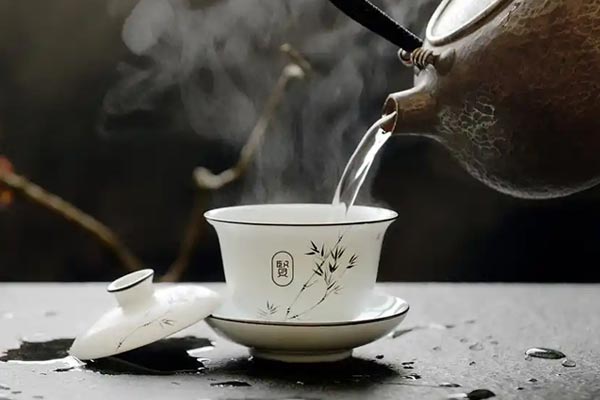Ancha tea processing is primarily divided into four stages:
- Preliminary Processing,
- Refining,
- Steaming and Forming,
- Storage and Aging.
The preliminary processing stage uses fresh leaves harvested during the Grain Rain season. These are spread out, withered, rolled, and finally dried to create the raw Ancha tea.
This raw tea often determines the taste of the subsequent Ancha tea.
Recently, a team from Anhui Agricultural University published a paper titled "Sensomics Evaluation of Sun Drying for Reducing the Bitterness and Astringency of Crude Ancha Tea" in npj Science of Food, revealing the scientific wisdom behind reducing the bitterness and astringency of Ancha tea.
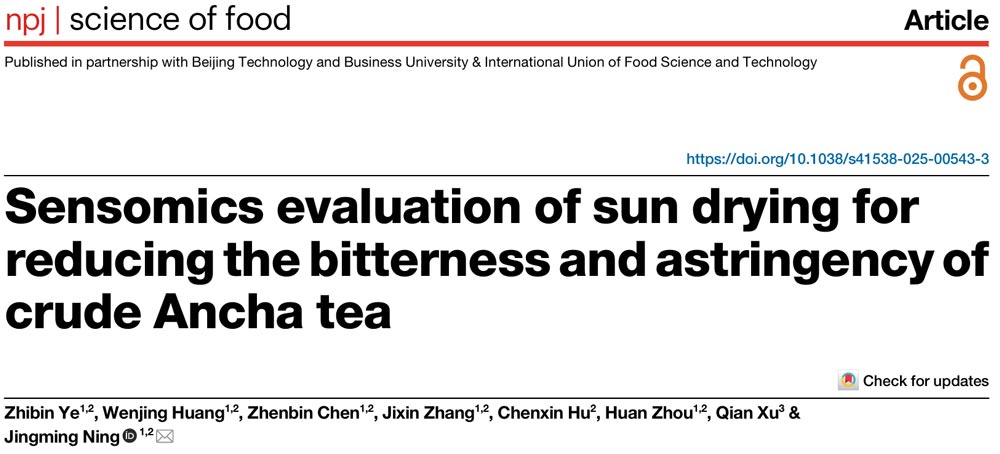
◆ Research Results
01. Sun-dried Tea Has the Least Astringency
Researchers divided the rolled tea leaves into three batches and dried them using different methods. The results were then verified using professional tea grading and precision instruments to determine which tea had the least bitterness:
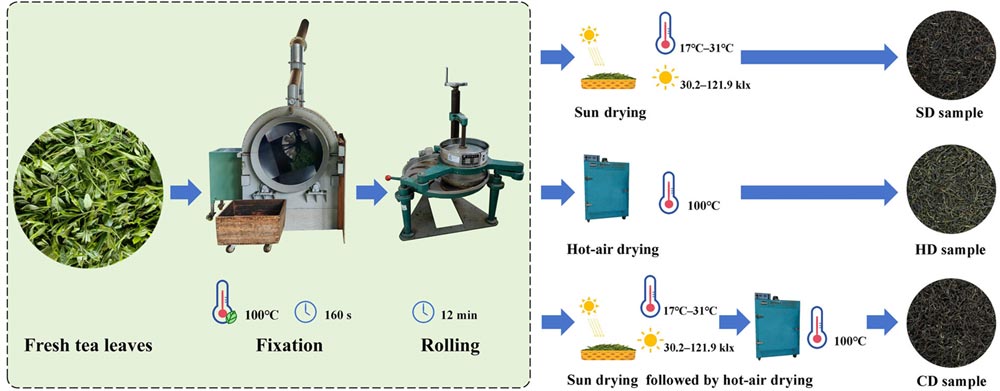
Three Drying Methods for Processing An Tea (Raw Tea)
- Hot Air Drying (HD): This method, aimed at efficiency, uses direct 100°C hot air drying for 40 minutes to quickly dry the tea.
- Sun Drying (SD): A traditional, slow drying method, using the sun for 11 hours until completely dry, using low temperatures throughout the drying process.
- Combined Drying (CD): This method, balancing tradition with efficiency, involves first drying the tea for 6 hours, followed by a 100°C hot air drying for 15 minutes.
Ten experts, wearing nose clips (to prevent aroma from interfering with taste perception), then rated the three teas (0 = no flavor, 5 = very strong flavor). The results are clear:
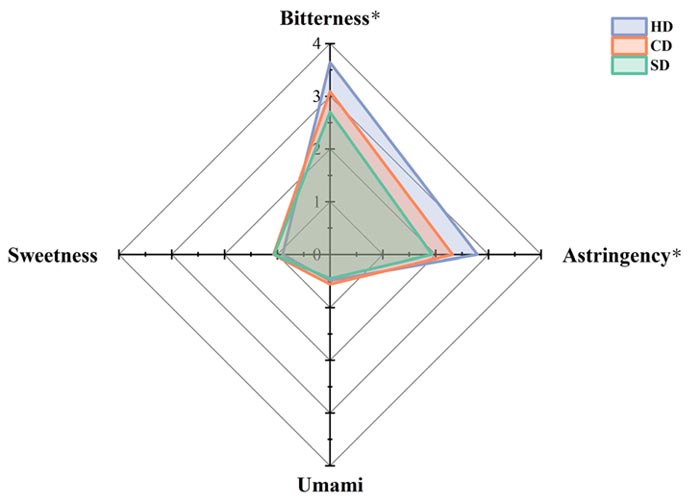
Taste Ratings of Raw Tea Using Different Drying Methods
- Bitterness: Hot-air-dried tea scored 3.64, combined-dried tea scored 3.09, and sun-dried tea was the lowest, at 2.70.
- Astringency: Hot-air-dried tea scored 2.79, combined-dried tea scored 2.32, and sun-dried tea was still the lowest, at 1.93.
In other words, sun-dried raw tea far outperformed the other two in reducing bitterness and astringency.
02. The "Drivers" of Bitterness and Astringency
Tasting alone isn't enough; researchers used sophisticated instruments to identify the key players in tea that influence bitterness and astringency.
Of the 33 differential metabolites, six directly determine taste:
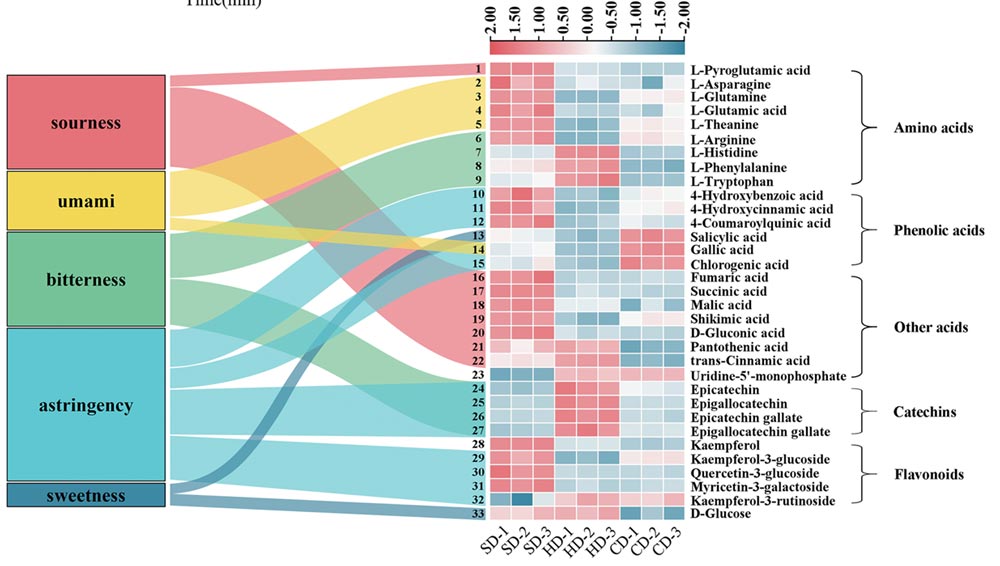
Comparison of Metabolites Under Different Drying Processes
• Troublesome Molecules Causing Bitterness and Astringency:
Epicatechin Gallate (ECG), Epigallocatechin Gallate (EGCG), and Kaempferol-3-Rutinoside (Kae-rut). Kae-rut, in particular, has the strongest astringency.
• Friendly Molecules that Neutralize Bitterness:
Kaempferol-3-Glucoside (Kae-glc), Quercetin-3-Glucoside (Que-glc), and Myricetin-3-Galactoside (Myr-gala). These molecules can indirectly reduce bitterness and astringency.
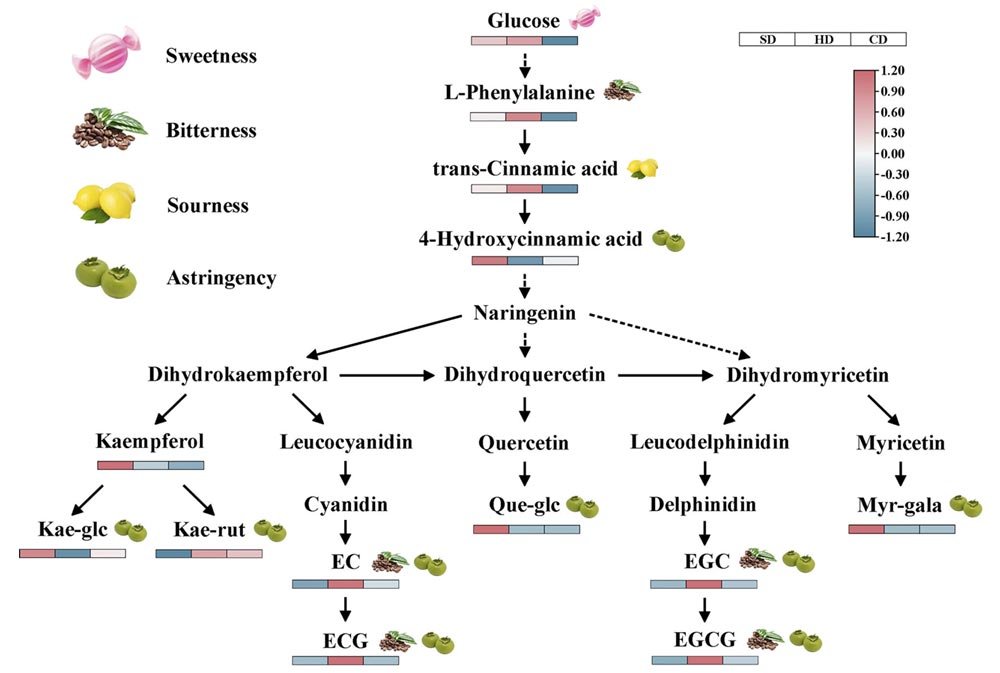
The drying process regulates changes in bitter and astringent substances.
The magic of sun-drying lies in precisely regulating the levels of these six substances:
It reduces "troublemakers" like ECG, EGCG, and Kae-rut, while increasing "friendly molecules" like Kae-glc, Que-glc, and Myr-gala.
In addition, sun-drying reduces tea polyphenols in tea leaves—a key source of bitterness and astringency. The polyphenol content in sun-dried tea is 15.5% lower than in hot-air-dried tea, further reducing the bitterness of the tea.
03. Caffeine: Only Increases Bitterness, Not Astringency
Many people believe that "tea bitterness is entirely due to caffeine," but research suggests otherwise:
The caffeine content of raw tea dried using the three drying methods is virtually identical (17.79 mg/g for sun-dried tea and 17.92 mg/g for hot-air-dried tea), so caffeine does not contribute to different bitterness levels in teas dried using different methods.

Caffeine's Enhanced Effect on Bitterness
However, caffeine is actually a bitterness amplifier:
A solution prepared with caffeine alone can produce a bitterness level of 46%-57% of the original raw tea liquor; mixing caffeine with the six key ingredients perfectly restores the original raw tea's bitterness.

Caffeine Has No Effect on Astringency
Conversely, caffeine has no effect on astringency at all—the astringency rating for the solution with caffeine added is similar to that of the solution without.
◆ Conclusion
In the past, tea farmers relied on sun-drying techniques or opted for hot air for efficiency, unaware of the underlying principles.
It turns out that sun-drying isn't just an old-fashioned method that relies on the weather; it's a scientifically proven method for reducing astringency.
It utilizes the characteristics of low-temperature, slow drying to subtly adjust the chemical composition of the tea leaves, making An tea less bitter and more palatable.
Disclaimer: This article is for informational purposes only and does not constitute commercial or medical advice.

%20--%3e%3c!DOCTYPE%20svg%20PUBLIC%20'-//W3C//DTD%20SVG%201.1//EN'%20'http://www.w3.org/Graphics/SVG/1.1/DTD/svg11.dtd'%3e%3csvg%20version='1.1'%20id='图层_1'%20xmlns='http://www.w3.org/2000/svg'%20xmlns:xlink='http://www.w3.org/1999/xlink'%20x='0px'%20y='0px'%20width='256px'%20height='256px'%20viewBox='0%200%20256%20256'%20enable-background='new%200%200%20256%20256'%20xml:space='preserve'%3e%3cpath%20fill='%23FFFFFF'%20d='M194.597,24.009h35.292l-77.094,88.082l90.697,119.881h-71.021l-55.607-72.668L53.229,232.01H17.92%20l82.469-94.227L13.349,24.009h72.813l50.286,66.45l58.148-66.469V24.009z%20M182.217,210.889h19.566L75.538,44.014H54.583%20L182.217,210.889z'/%3e%3c/svg%3e)



